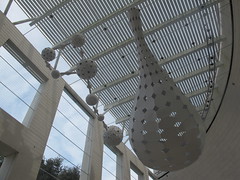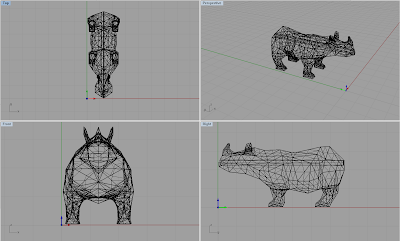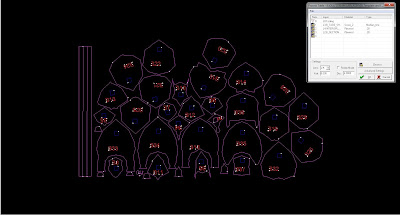Follow the Drinking Gourd. Laser cut Cardboard.
Monday, February 27, 2012
Wednesday, February 22, 2012
Rex Brodie - Rust Never Sleeps
Currently working on finishing a sculpture I started this fall … reached a point where I couldn’t move forward so I put it aside. Found the perfect parts (rusty I-beam and rail road plates) to complete the piece in the scrap bin at Boundary hall. All the materials are recycled including the oval laser cut parts which I found in the trash. The rusty cans are from the dilapidated barn behind our apartment in Connecticut.
Made from rusty tin cans, Rust Never Sleeps is a metaphor for the slow and often unnoticeable decay of all things seemingly permanent. One day you’re young, the next you’re old and falling apart.
Labels:
impermanence sculptures,
metal sculpture,
rex brodie
Thursday, February 16, 2012
Rex Brodie - FDM Studies
This piece, Creative Synapse, is an off shoot of the Life Force sculptures. The more representational biology imagery was in part inspired by a TED video by Drew Berry. Berry creates scientifically accurate animations of the microscopic cells inside our bodies. Like scientist, artists can play a role in developing our understanding of the world by representing the intangible.
In her article, Image as Insight :Visual Images in Practice-Based Research, artist and art educator Julia Marshall talks about the connection between art and science through an analogy between the artmaking process and developing a scientific theory. Like a scientific hypothesis, the “art image” illustrates the artist “theory of reality.” Moreover she goes on to say:
“artist are theorist; they question, observe, analyze, synthesize, and hypothesize as scientist do and shape thought into conceptual images, which are often metaphorical…art images manifest an individual artist’s hypothesis or interpretations of reality that resonate with others.”Part of my MFA thesis will explore Edward Hall’s concept of “extentions” and how human evolution has been accelerated by them. In his book, The Hidden Dimension he explains that :
“By developing his extensions, man has been able to improve or specialize various functions. The computer is an extension of our brain, the telephone extends the voice, and the wheel extends the legs and feet. Language extends experience in time and space while writing extends language.”
He goes on to describe how humans have advanced these “extensions” to the point that they are “rapidly replacing nature” in our development. Hall believes that we have created a “biotope,” a uniform environment that is “actually determining what kind of an organism we will be.”
In Creative Synapse the digitally fabricated neurons are intended to represent computer technologies influence on our creativity and evolution.
I started my sculpture by downloading an accurate 3D model of a neuron from the TurboSquid website. Like any object, existing 3d models are there for the taking to be appropriated for artistic proposes.
Using Maya, I then modified the size of some of the parts to increase their strength for the FDM printing … I became thoroughly acquainted with the insert edge tool.
Through the creative use of the duplicate with transform tool (Shift+D), I created the composition for my sculpture.
Since I plan to use the FDM parts in a sculpture, I separated the individual parts and suspended them in a 6x6x8 cage for printing. Hopefully the cage will help the delicate parts survive process.
Sunday, February 12, 2012
Joseph Willet:: Grasshopper and Laser Cutter Studies
This work is an experimentation using Rhino, Grasshopper and laser-cutting technology to create 3D sculpture.
First, the model was created using Rhino through poly-surfaces.
After the model has been completed a script was run in Grasshopper to serial slice the object and create 2D curves based on the parameters specified in the code. These 2D curves were then arranged efficiently and labeled appropriately for the laser-cutting software.
Once appropriately labeled the file was programmed to cut on the specified material under specific settings.
LASERS!!!!
Once laser-cut the individual serial slices were reassembled with PVA Glue.
Lastly, the Rhino, who was developed using Rhino, Grasshopper, and laser-cutting technology is ground down to revealed his tough exterior hide.
Monday, February 6, 2012
Leslie Martin: Milling
For the milling project, I decided to make an inverse imprint of a foot. With the milled result, I can cast it, make vacuum forms, or possibly even make an imprinting stamp.
I first modeled the foot in Maya using polygons, then converted the polys to subdivs, and subdivs to NURBS. transition left me with a gross pinched surface on the back, but I intended to cut that face off anyway so it didn't matter. I exported the NURBS surface as an .IGES file, and imported it into Rhino. I did a Boolean union to put the backplate on the foot, which got rid of the pinched back and gave the foot some context.
The idea behind this project is that I can use this foot to make imprints in materials like some weird creature has been there, or I can use it as in inverse footprint (more would be created with vacuum forming) and make it seem like these creatures are walking on the other side of the Earth's crust, and making inverse imprints on our side.
For the keyshot render, I used materials that look man-make as if it were an installation piece. This is because the backplate makes it obvious that it is not a real footprint, and it could be a statement about the unknown.
For the sculptural setting, I chose a flat cobblestone background on which to place the foot. It is actually in a parking space in the image, which is understandable because were it a large sculpture I would want to place it in a spot that is out of the ordinary. I want to make people think- what good is a piece of art if it doesn't serve a purpose? Placing it in a parking space would at least make someone question what it is and why it is there, and that questioning is the first step towards rationalizing. Rationalizing requires thought, so even if the spectator comes to an entirely different conclusion than was intended, my work is successful.
If there were more options that I knew how to use in keyshot, it would have been interesting to give the foot a dirt texture and place it in the woods or on a barren plain, making it seem like there actually were creatures walking upside down from us underneath the Earth's crust. It would be funny to see the reactions of spectators viewing such a sculpture.
I will post a better Keyshot render (with passes) later.
I first modeled the foot in Maya using polygons, then converted the polys to subdivs, and subdivs to NURBS. transition left me with a gross pinched surface on the back, but I intended to cut that face off anyway so it didn't matter. I exported the NURBS surface as an .IGES file, and imported it into Rhino. I did a Boolean union to put the backplate on the foot, which got rid of the pinched back and gave the foot some context.
 |
| Maya Polygons |
 |
| Maya NURBS |
 |
| Rhino final file |
The idea behind this project is that I can use this foot to make imprints in materials like some weird creature has been there, or I can use it as in inverse footprint (more would be created with vacuum forming) and make it seem like these creatures are walking on the other side of the Earth's crust, and making inverse imprints on our side.
For the keyshot render, I used materials that look man-make as if it were an installation piece. This is because the backplate makes it obvious that it is not a real footprint, and it could be a statement about the unknown.
 |
| Keyshot |
 |
| Keyshot sculptural setting |
If there were more options that I knew how to use in keyshot, it would have been interesting to give the foot a dirt texture and place it in the woods or on a barren plain, making it seem like there actually were creatures walking upside down from us underneath the Earth's crust. It would be funny to see the reactions of spectators viewing such a sculpture.
I will post a better Keyshot render (with passes) later.
Labels:
afscott,
keyshot,
maya,
maya2rhino,
Milling,
nurbs2iges,
poly2nurbs,
Project 1,
rhino,
scpt250450
Sunday, February 5, 2012
A serious pair of serial eyes
Surreal Head Sculptures Cut From Layered Paper
"Beijing-based artist Li Hongjun cuts into layers and layers of paper to create these surreal head sculptures. Called one of the most striking artists of sculpture in Chinese mainland, Hongjun uses eastern and western methods of paper cutting to create these magnificent, mind-bending works. According to ArtLinkArt, he "digs" his desired images out. "After digging the negative configuration, [it] also becomes a part of the whole work. We can say this principle is not created by Li Hongjun, [but] is a precious heritage left by Chinese Traditional Paper-cut."
Rex Brodie - Laser Studies
Ah ... the existentialist funk of turning fifty makes one question what it’s all about.
Historically, the role of the artist has been to present us with ideas and perceptions for our contemplation. The goal of many artists has been to create a “critical consciousness” that questions cultural traditions. As Suzi Gablick points out in her book Has Modernism Failed:
"There is always a correlation between society’s values, directions, and motives and the art it produces. Modernism, as we have seen, has cultivated its objects largely as a mode of cultural resistance–as antidotes to a bureaucratically administered and overrationalized way of life."
The inclusion of forms derived from digital fabrication techniques into my work is an attempt to explore the relationship between technology and society. I agree with historian Merrit Roe Smith’s theory of technological determinism, “the belief that technology is the key governing force in society.” Utopian visions of technology and the notion of “technology as liberator” have been instrumental in shaping the construct of our reality. As an artist, I believe it is important to think critically about the uses of technology.
One of the pieces I’m currently working on, Life Force, clings to the romantic modernist notion that the mark of the artist is a uniquely individual expression of the spirit. The bone-like forms in the sculptures are mechanically reproduced on the laser cutter and assembled into organic compositions. Conceptually, the process is as important as the final art object. By using the technology of industry—particularly, the digital fabrication technology used by “commodity-producers” of aesthetic “goods”—in an improvisational manner and juxtaposing the precise repetitive machine made parts with the free-form elements created by the artist's hand, I hope to create a sculpture which questions technology’s impact on our identity and perception of self.
With no preconceived form in mind, I experimented in Rhino until I discovered an appropriate shape.
I brought the shape into illustrator to change the scale and create the file for the laser cutter. The notch was added after doing some experimenting upon receiving my first batch of laser cut parts.
Prior to this quarter, the sculptures I’ve been working on have been an exploration of the impermanent nature of life. Variable building materials, some with long histories of being used for structurally sound objects like shelter and furnishings, are precariously held together with clamps and zip ties.
Continuing with this concept, the first avenue I followed was to create a wooden form held together with thumb screws and pressure-fit joints. The only permanent part of the structure is the bent lamination in the middle of the piece which was necessary for support. The other bent forms were created—while listened to Miles Davis—using a hot pipe method.
Like the pinch clamps and zip ties, the thumb screws are paradoxically both captor and liberator. While they allow me to bind materials together, they also liberate me from making permanent connections … allowing for greater freedom for improvisation.
Moving away from the idea of impermanence, I decided to explore the use of steel as a supporting structure. Steel allows for a variety of different forms not possible with wood. However, it is much more difficult to control and does not allow the subtle twists and bends that wood does.
I was thinking of my father-in-law and his Alzheimer’s when I decided to add the neuron-like forms made from zip-ties and tile spacers. Still a work in progress ... I’m not exactly sure of where this one is headed but then that’s the nature of the unknown.
Update: 2/16/2012
Update: 2/16/2012
The piece continues to evolve … decided include some more direct biological references by replacing the metal base with some representational (1/2” ply) hip bone cross sections.
Update: 3/9/2012
Several hundred parts cut and ready to assemble into a site responsive piece
Update: 3/9/2012
Several hundred parts cut and ready to assemble into a site responsive piece
Lately, I’ve been fascinated with the residual materials left over from the art-making process. Serendipitously, happy accidents often occur, and sometimes the remnants can be really spectacular. This is often true with the “waste” materials from the laser-cutting process. In this experiment, I am using the cut-offs from my laser cutting as well as some that I have found in the trash. Although my past use of color has been limited and I don’t really know what I’m doing with the pastels, I enjoy the process immensely. Who knows, maybe an “art” object will be the end result.
Ode to Brian Dettmer
Ode to Brian Dettmer
Brian Dettmer creates some truly amazing sculptures from old books. When he gave a lecture at SCAD last year, I had the good fortune to have a studio visit with him. What I like best about his work is his process: when he begins a piece, he has no preconceived plan. As he excavates the book, he allows what’s inside to dictate the direction he follows and to reveal the piece's meaning. Reminds me of a quote from the artist Paul Soldner:.
“There can be no fear of losing what was once planned, and there must be an urge to grow along with the discovery of the unknown … make no demands, expect nothing, follow no absolute plan, be secure in change, learn to accept another solution, and, finally, prefer to gamble on your own intuition.”I thought it would be interesting to cut a book with the laser cutter. My original concept was to create a piece about the abject of beauty in art. I wanted to slice a Victorian lace pattern from a book on contemporary art and then rearrange the pages into a sculpture. Unfortunately, laser burns the book more than I had hoped. The lace pattern was too tight, and the book caught fire when we tried to run it! I had to settle for a simple geometric shape.
Not exactly what I had in mind, but the end result was visually interesting. However, it would be difficult not to get some interesting combinations when you’re working with images of work created by great contemporary artist .
To date, I have created several forms using the serial slicing technique—I really like the texture and patterns of the cardboard. I will combine these with some forged steel elements later in the quarter.
Update: 2/21/2012
Update: 2/21/2012
Working old school using Professor Scott’s manual approach for creating ribs…
Subscribe to:
Comments (Atom)



































